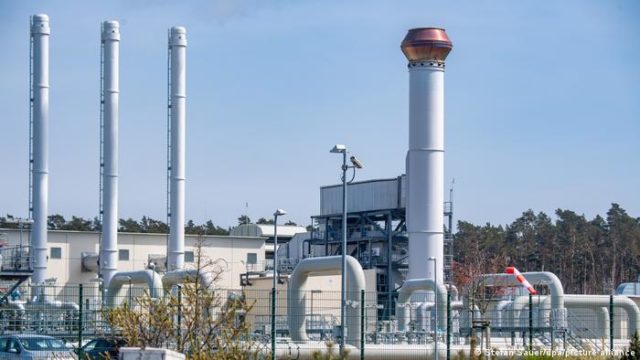
Despite Return of Nord Stream One Turbines, Europe Still Fears Winter Gas Shortages
Publication: Eurasia Daily Monitor Volume: 19 Issue: 103
By:

On July 9, Canadian Minister of Natural Resources Jonathan Wilkinson announced that his country will return confiscated Nord Stream One turbines to Germany, providing Siemens with a temporary exemption from the existing sanctions regulations (La Presse, July 9). The equipment was seized by Canadian authorities, and the case has been used by Moscow to justify cutting natural gas supplies to Europe. According to Kremlin spokesperson Dmitriy Peskov, the return of the turbines should allow Gazprom to boost gas flows via Nord Stream One (1prime.ru, July 8). However, this may only happen after July 21, as the pipeline is annually shut off from July 11 to July 21 for maintenance.
In general, Gazprom’s natural gas deliveries to Europe have been substantially reduced since the beginning of the Russian re-invasion of Ukraine (despite a small initial export boost until mid-March 2022), and the current level now stands at an all-time low. Based on average weekly data, current flows from Russia to the European Union equal about half of what was being sent six months ago and only a third of what was shipped in July 2021 (Bruegel, July 6). The situation results from two main direct factors: Gazprom’s unilateral breach of supply contracts with several European customers and the Kremlin’s decisions to limit the use of existing gas pipeline corridors (see EDM, May 2; GasTerra, May 30; Orsted, May 31).
Speaking precisely, currently, of the four main pipelines that transport Russian gas, only TurkStream (via the Black Sea) is operating normally. The Yamal-Europe pipeline via Poland is not being used, as Moscow imposed sanctions on the owner of the Polish section (EuRoPolGaz), and gas flows via Ukraine (Brotherhood system) remain limited. Moreover, since the beginning of June 2022, Nord Stream One has been operating at 40-percent capacity due to the seized turbine issue, which directly translated into supply cuts for Austria, the Czech Republic, France, Germany, Italy and Slovakia (Interfax, June 15).
The situation has a tremendous impact on European gas security and has already affected the gas storage filling rate, threatening EU countries with the prospect of entering the winter without enough reserves. The most alarming signals are being sent from the German side. According to analysis by Germany’s energy regulator, if the gas flows via Nord Stream One do not rise (or are completely halted after maintenance), then Germany will most likely run out of gas during the coming winter (Bundesnetzagentur.de, June 21). According to a widely quoted interview with German Vice Chancellor and Minister of Economic Affairs Robert Habeck, this would cause the collapse of certain industrial sectors in the country and possibly create a full-scale economic crisis (Spiegel.de, June 24). Additionally, it will have a devastating effect on the EU as a whole—both because of the gas shortages in specific countries and because of how closely European economies are interlinked with the German economy.
At the moment, it is impossible to forecast whether and when Gazprom could increase its gas supplies to Europe. On the one hand, the energy company should indeed do so after Nord Stream One maintenance is completed, as Germany will probably hand over the disputed turbines to Russia. On the other, assurances are needed that Russia will not point to any other technical or legal issue that will prevent a boost in gas flow to the rest of Europe. At the moment, theoretically, it seems the Kremlin has three central reasons for further escalating the energy crisis in Europe, as the overall hypothetical gains for Moscow might easily exceed the costs.
First, record-high gas prices continue to reward Gazprom, even though the company has sharply reduced the volume of gas sold. Indeed, Gazprom still earns more money than it collected in previous years, and the surplus will effectively contribute to the Russian government’s budget, as the company will be charged a new windfall tax in coming months (Twitter.com/tmarzecmanser, June 23; Interfax.ru, July 5).
Second, for the Kremlin, sparking and accelerating the gas crisis in Europe remains a key Russian strategy against the West. Due to the energy market situation (global imbalance of liquefied natural gas supply and demand) and the still insufficient regasification and transmission infrastructure within the EU, Russian natural gas now represents a necessary evil for many European countries (including Germany and Austria). Prolonged disruptions in deliveries from Gazprom might indeed result in a full-scale economic crisis this winter, and in turn, this may significantly affect the political stability and unity within the 27-member bloc.
Third, shutting off Nord Stream One due to—real or fabricated—technical reasons might be used by the Russians to lobby for the restart of the Nord Stream Two project. The pipeline was technically completed before the war started and could hypothetically be used for shipping increased quantities of Russian natural gas to Europe. Therefore, if Gazprom continues to limit supplies via Nord Stream One, it could then potentially advocate for redirecting some flows via Nord Stream Two. This of course would also be used by the Kremlin to create divisions within the EU and weaken the political unity of the West.
For now, we do not know what strategy Russia will choose regarding natural gas supply to Europe. What seems unquestionable, however, is that EU countries should not feel secure even if Nord Stream One flows resume to previous levels after maintenance or supplies grow in the coming weeks. It lies in Russia’s interest to disrupt European preparations for the winter, and the process of rebuilding gas inventories in the EU is still three to four months from being complete. As such, the ultimate outcome remains uncertain.



